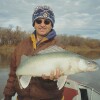PALMVILLE WILDLIFE MANAGEMENT AREA, Minn. – On a beautiful April Saturday when signs of spring were everywhere, a group of ambitious volunteers – mainly university wildlife students – spent a few hours outdoors helping wildlife.
Specifically, habitat for sharp-tailed grouse.
The students – from The Wildlife Society chapters at the University of Minnesota Crookston and Bemidji State University – and a half-dozen-or-so other volunteers had converged on Palmville WMA with loppers and hand saws to cut brush that was encroaching on the open habitat sharp-tailed grouse need to survive and thrive.
Located northeast of Middle River, Minnesota, in Marshall and Roseau counties, the 14,890-acre WMA offers a mix of forest, open-land and wetland areas, providing habitat for a variety of species, not the least of which are sharptails.
The Minnesota Sharp-tailed Grouse Society (MSGS) has hosted spring brush-cutting events in northwest Minnesota for “a long time, maybe 15-20 years,” expanding the effort to sharptail range in east-central Minnesota about “three or four years ago,” according to Gary Huschle of Clearbrook, Minnesota, a retired U.S. Fish and Wildlife Service biologist and regional MSGS representative for northwest Minnesota.
ADVERTISEMENT
Sharptails generally are doing well in northwest Minnesota, Huschle said, while populations in the east-central part of their range have declined to the point where the Department of Natural Resources no longer offers a season.
Spring surveys counting male sharptails on their leks, or dancing grounds, as they vie to attract a mate are currently underway.
“Here in the northwest, I think we’re holding our own,” Huschle said. “And maybe even because of the easy winter this year, we should see an increase in numbers, I think. It wasn’t ever cold enough that they needed snow for roosting.
“I think the mild winter should be a benefit to them this year.”
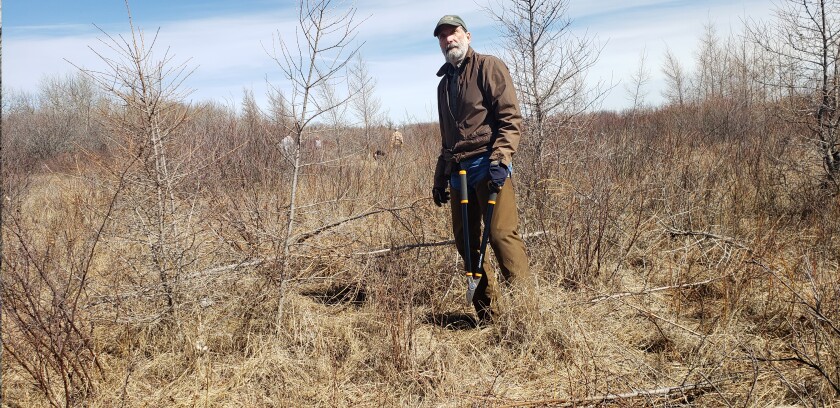
Getting to work
Brush such as willows, aspen and small tamarack trees were the primary targets of the Palmville brush-cutting event Saturday, April 6. Besides the university students, other volunteers on hand were two of Huschle’s grandsons, Aaron and Evan Langerak, who live near Bemidji; Kyle Arola, manager of Thief Lake WMA who also oversees the Palmville site; John Loegering, UMC professor of wildlife ecology and adviser of the student Wildlife Society chapter; James Meadow of Duluth, MSGS regional rep for northeast Minnesota; and MSGS volunteer Joe Lesmeister of Thief River Falls.

Much of Palmville WMA falls within the Tallgrass Aspen Parkland region of Minnesota, a biome that requires disturbance to maintain its quality, said Arola, the WMA manager.
“You can see where the brush and tamarack is really taking over, and that’s just a natural part of succession,” Arola said. “Over time in these open areas, the brush and tamarack trees encroach, and then at some point, it isn’t as suitable as habitat for the sharp-tailed grouse.”
ADVERTISEMENT
Historically, Arola said, fire would have kept that encroachment in check, but because the WMA is close to homes and private land, prescribed burning isn’t a feasible management tool on much of the site.
That’s where the Minnesota Sharp-tailed Grouse Society’s brush cutting efforts come into play. Sharptails generally rely on the open areas of Palmville WMA for winter snow-roosting cover, Arola said.
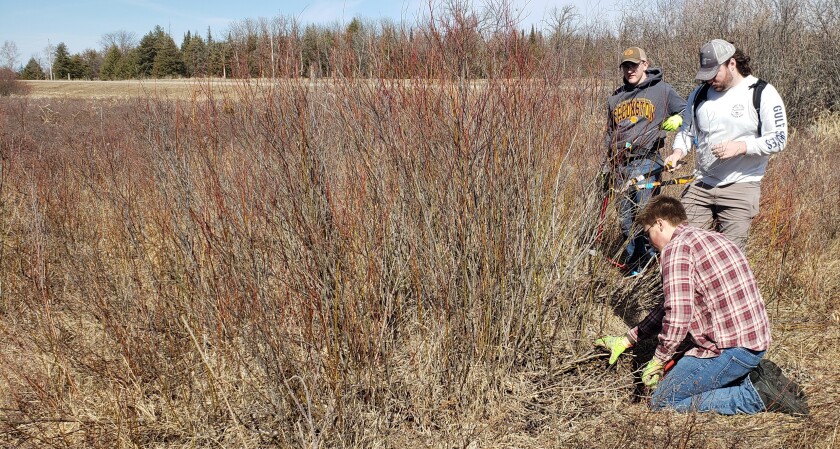
“This is the third brush cut we’ve done at this site,” he said. “Our goal is to get disturbance within these areas every three to five to seven years. And we’ve done a pretty darn good job just with manual labor and a lot of people coming out here to keep this open.”
Zoom out on the surrounding area, Arola says, and agriculture dominates much of the landscape.
“You go into the winter without a lot of cover,” he said. “You have tilled-up black fields, and areas like this are very important for wintering habitat for the birds.”
The volunteer efforts make a big difference, Arola says.
“I think this is the biggest crew we’ve had,” he said. “It’s neat to see Bemidji State and Crookston come out.
“It makes a big impact on the area itself and the site we’re working on today.”
ADVERTISEMENT
Leveraging volunteer labor
The volunteer effort also helps satisfy the in-kind match requirement for grants the MSGS receives through Minnesota’s Conservation Partnership Legacy grant program, Arola said. CPL is a subset allocation of the Outdoor Heritage Fund, part of the Clean Water, Land and Legacy Amendment that Minnesota voters passed in 2008 by approving a three-eighths of 1% sales tax increase.
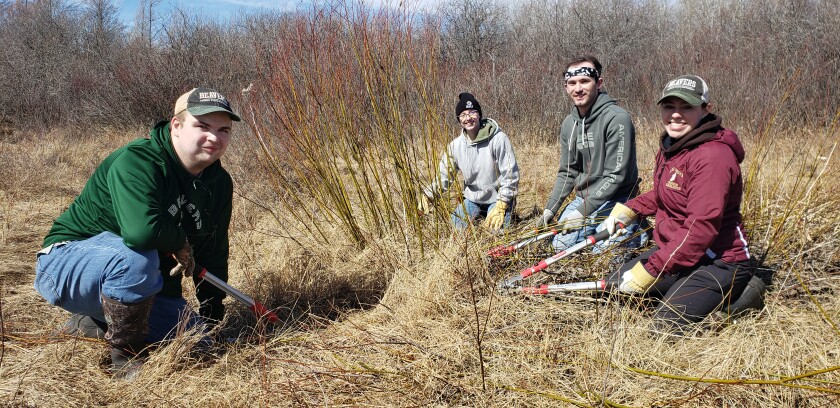
Most recently, Arola said, the MSGS applied for a $50,000 grant to restore openland/shrubland habitats by hiring a contractor to mechanically mulch brush and sapling aspen in a large habitat area that hasn’t seen disturbance in more than a decade. That will set the stage for prescribed fire using the “fine fuels” that remain and allow for better long-term management of the habitat complex going forward, to the benefit of sharp-tailed grouse, moose and elk.
As a grant requirement, the MSGS must provide a match of 10% of the grant allocation – in this case $5,000 – whether it be a cash match, which can be a donation from a partner or in-kind labor – Arola said. Every volunteer participating in last Saturday’s brush-cutting event was able to claim the hours at a rate of $28.54 per hour, he said.
At the end of the day, the 28 volunteers last Saturday gave 221.5 hours of volunteer labor, which equates to $6,321.61 as in-kind match funds, said Arola, who also is MSGS vice present.
“This is our in-kind match, easily fulfilling – even over-achieving – the 10% match requirement,” he said.
Tangible results
With no snow on the landscape, the students and other volunteers made short work of the encroaching brush at the Palmville work site, lopping and sawing the brush and small tamarack as close to the ground as possible, while saving the bog birch, an important winter food source for sharptails.
The results of the effort were tangible, and the site was noticeably less brushy by the time the volunteers wrapped up a few hours well spent.
ADVERTISEMENT
The ultimate goal wasn’t to open the whole area, UMC’s Loegering said.
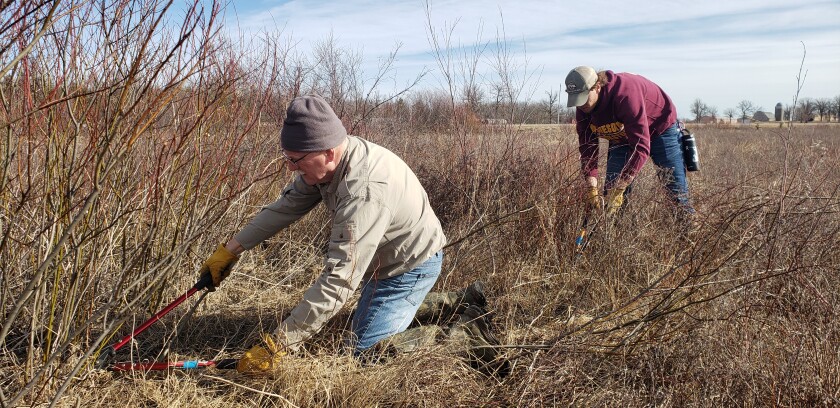
“You have to make the core area a little bit bigger and just keep making that circle larger, taking out the species that are contributing to woody encroachment,” Loegering said.

The volunteer brigade wrapped up their time outdoors with a lunch of chili and hot dogs at nearby Thief Lake WMA headquarters. It should be noted that UMC, with 11 participants counting Loegering, won this year's “Golden Saw Award” for the best university turnout, edging the BSU delegation by one.
It had been a rewarding – and productive – few hours.
“We have a lot of great conversations about wildlife that use the area, the habitat needs and why we’re doing it,” Loegering said of the brush-cutting effort. “There’ll be some conversation and reflection on that on the car ride home.
“It’s a great opportunity.”
Not to mention a great cause.
- On the web:
ADVERTISEMENT



